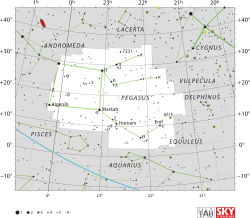Theta Pegasi
θ Pegasi, Latinized as Theta Pegasi, is a single[7] star in the equatorial constellation of Pegasus, lying about 7.5 degrees southwest of Enif.[8] It has the traditional name Biham /ˈbaɪ.æm/,[9][10] and the Flamsteed designation 26 Pegasi. This object is visible to the naked eye as a white-hued point of light with an apparent visual magnitude of +3.52.[2] The system is located 92 light years from the Sun based on parallax, but is drifting closer with a radial velocity of −8 km/s.[2]
 | |
| Observation data Epoch J2000.0 Equinox J2000.0 | |
|---|---|
| Constellation | Pegasus |
| Right ascension | 22h 10m 11.98528s[1] |
| Declination | +06° 11′ 52.3078″[1] |
| Apparent magnitude (V) | +3.52[2] |
| Characteristics | |
| Evolutionary stage | main sequence[3] |
| Spectral type | A2V[4] |
| B−V color index | 0.086±0.002[2] |
| Astrometry | |
| Radial velocity (Rv) | −7.9±2.4[2] km/s |
| Proper motion (μ) | RA: +282.18[1] mas/yr Dec.: +30.46[1] mas/yr |
| Parallax (π) | 35.34 ± 0.85[1] mas |
| Distance | 92 ± 2 ly (28.3 ± 0.7 pc) |
| Absolute magnitude (MV) | 1.24[2] |
| Details[4] | |
| Mass | 2.14[5] M☉ |
| Radius | 2.6225±0.0829 R☉ |
| Luminosity | 23.7012±1.1418 L☉ |
| Surface gravity (log g) | 3.95[5] cgs |
| Temperature | 7872±82 K |
| Metallicity [Fe/H] | −0.38 dex |
| Rotational velocity (v sin i) | 136[5] km/s |
| Age | 448[5] Myr |
| Other designations | |
| Database references | |
| SIMBAD | data |
This object an A-type main-sequence star with a stellar classification of A2V.[4] It is 448[5] million years old with a high rate of spin, showing a projected rotational velocity of 136 km/s.[5] This star has 2.14[5] times the mass of the Sun and 2.6[11] times the Sun's radius. It is radiating 25 times the luminosity of the Sun from its outer envelope at an effective temperature of 7,951 K.[11] The star appears to display a slight infrared excess.[12]
Nomenclature
θ Pegasi (Latinised to Theta Pegasi) is the star's Bayer designation.
It bore the traditional name Biham or Baham from the Arabic phrase s'ad al Biham "Lucky Stars of the Young Beasts".[13] In 2016, the International Astronomical Union organized a Working Group on Star Names (WGSN)[14] to catalogue and standardize proper names for stars. The WGSN approved the name Biham for this star on 21 August 2016 and it is now so entered in the IAU Catalog of Star Names.[10]
In Chinese, 危宿 (Wēi Sù), meaning Rooftop, refers to an asterism consisting of Theta Pegasi, Alpha Aquarii and Epsilon Pegasi.[15] Consequently, the Chinese name for Theta Pegasi itself is 危宿二 (Wēi Sù èr, English: the Second Star of Rooftop.)[16]
References
- van Leeuwen, F. (2007), "Validation of the new Hipparcos reduction", Astronomy and Astrophysics, 474 (2): 653–664, arXiv:0708.1752, Bibcode:2007A&A...474..653V, doi:10.1051/0004-6361:20078357.
- Anderson, E.; Francis, Ch. (2012), "XHIP: An extended hipparcos compilation", Astronomy Letters, 38 (5): 331, arXiv:1108.4971, Bibcode:2012AstL...38..331A, doi:10.1134/S1063773712050015.
- Zorec, J.; et al. (2012), "Rotational velocities of A-type stars. IV. Evolution of rotational velocities", Astronomy and Astrophysics, 537: A120, arXiv:1201.2052, Bibcode:2012A&A...537A.120Z, doi:10.1051/0004-6361/201117691.
- Boyajian, Tabetha S.; et al. (July 2013), "Stellar Diameters and Temperatures. III. Main-sequence A, F, G, and K Stars: Additional High-precision Measurements and Empirical Relations", The Astrophysical Journal, 771 (1): 31, arXiv:1306.2974, Bibcode:2013ApJ...771...40B, doi:10.1088/0004-637X/771/1/40, 40. See Table 3.
- David, Trevor J.; Hillenbrand, Lynne A. (2015), "The Ages of Early-Type Stars: Strömgren Photometric Methods Calibrated, Validated, Tested, and Applied to Hosts and Prospective Hosts of Directly Imaged Exoplanets", The Astrophysical Journal, 804 (2): 146, arXiv:1501.03154, Bibcode:2015ApJ...804..146D, doi:10.1088/0004-637X/804/2/146.
- "tet Peg". SIMBAD. Centre de données astronomiques de Strasbourg. Retrieved 2019-08-31.
- De Rosa, R. J.; et al. (2013), "The VAST Survey - III. The multiplicity of A-type stars within 75 pc", Monthly Notices of the Royal Astronomical Society, 437 (2): 1216, arXiv:1311.7141, Bibcode:2014MNRAS.437.1216D, doi:10.1093/mnras/stt1932.
- Mollise, Rod (2012), Choosing and Using a Schmidt-Cassegrain Telescope: A Guide to Commercial SCTs and Maksutovs, The Patrick Moore Practical Astronomy Series, Springer Science & Business Media, p. 205, ISBN 9781447102274.
- Kunitzsch, Paul; Smart, Tim (2006), A Dictionary of Modern star Names: A Short Guide to 254 Star Names and Their Derivations (2nd rev. ed.), Cambridge, Massachusetts: Sky Pub, ISBN 978-1-931559-44-7.
- IAU Catalog of Star Names, IAU, retrieved 28 July 2016.
- Boyajian, Tabetha S.; et al. (February 2012), "Stellar Diameters and Temperatures. I. Main-sequence A, F, and G Stars", The Astrophysical Journal, 746 (1): 101, arXiv:1112.3316, Bibcode:2012ApJ...746..101B, doi:10.1088/0004-637X/746/1/101.. See Table 10.
- Nuñez, P. D.; et al. (December 2017), "A near-infrared interferometric survey of debris-disc stars. VI. Extending the exozodiacal light survey with CHARA/JouFLU", Astronomy & Astrophysics, 608: 16, arXiv:1709.01655, Bibcode:2017A&A...608A.113N, doi:10.1051/0004-6361/201730859, A113.
- Kaler, James B. (October 15, 2010), "Biham", STARS.
- IAU Working Group on Star Names (WGSN), International Astronomical Union, retrieved 22 May 2016.
- (in Chinese) 中國星座神話, written by 陳久金. Published by 台灣書房出版有限公司, 2005, ISBN 978-986-7332-25-7.
- (in Chinese) 香港太空館 - 研究資源 - 亮星中英對照表 Archived 2010-08-11 at the Wayback Machine, Hong Kong Space Museum. Accessed on line November 23, 2010.